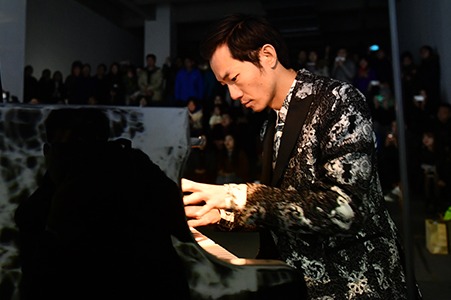



Chinese new-age pianist Ma Chen invited the audience to take a tour of his train of thought at the opening of the Cosmic AI exhibition by Ouchhh on Saturday.
"The exhibition lets the audience feel that music not only can be heard but also can be seen," says Ma.
"This is also the idea I wanted to convey through the Piano Picture project I have been working on."
Piano Picture is his long-term project, employing crossovers to attract more people to the music. It's based on the concept that music can be visual.
Every note can be compared to a certain color. Therefore, a music piece in a way resembles a painting, Ma says.
Over the years, he has devoted himself to the integration of sound and images to offer audiences more-vivid musical experiences, including piano compositions for photography exhibitions and music lectures with live performances.
Ma also specializes in crossovers of different music genres-electronic, classical, world music and jazz-to create his new-age easy-listening music.
His interest in crossover started at an early age. And like many of his fellow millennials, Ma did not like to play by the book, both figuratively and literally.
"I started learning the piano when I was a child, but I never liked to read the scores," says Ma.
"I would try to play familiar tunes on the piano without reading the sheet music, which amazed my teacher and other students."
Describing himself as a rebel while learning music, Ma says he chose to study electronic-music composition at the Central Conservatory of Music, China's leading music institution.
But Ma was not content with specializing in just one genre.
"I guess my capacity to learn music led to my not wanting to play in conventional ways. This is why I started exploring crossovers," he says.
"I wanted to compose and feel music in a free space."
Ma has been to a lot of places at home and abroad. He takes headphones wherever he goes.
"Even the most beautiful scenery seems pale without music. To me, music is not only auditory. Rather, it can apply a certain color to spaces. This is why I started the Piano Picture project," he says.
Over the past year, Ma has given a series of lectures on "music culture along the Belt and Road" at museums, galleries and universities in China, where he presented the music and culture of the countries and regions involved in the Belt and Road with live performances.
He's especially interested in promoting Chinese music and culture.
"I find Chinese culture endearing, be it ancient poetry, prose or ink paintings. I want to present Chinese culture through my compositions," he says.
"The project is now mostly conducted within the country. But I also hope to have the opportunity to make it an international one, to let more people from different nationalities and cultural backgrounds feel our culture."
The performance at the exhibition could be a starting point, as Ma introduces the use of Chinese instruments like the pipa (lute) and guqin (zither) in the highly futuristic eponymous theme music he composed for the exhibition.
Ferdi Alici, the founder of Ouchhh, says: "This cooperation is very important for us because, for the first time, we are using traditional instruments, particularly Chinese instruments. The sound is incredible, and the musicians are very good."
Ma says he will keep working with Ouchhh and TRU-M on multimedia projects, and further explore the relationships between the visual and the auditory.
After the exhibition, he will continue to produce easy-listening music that integrates other genres.
If you have any problems with this article, please contact us at app@chinadaily.com.cn and we'll immediately get back to you.